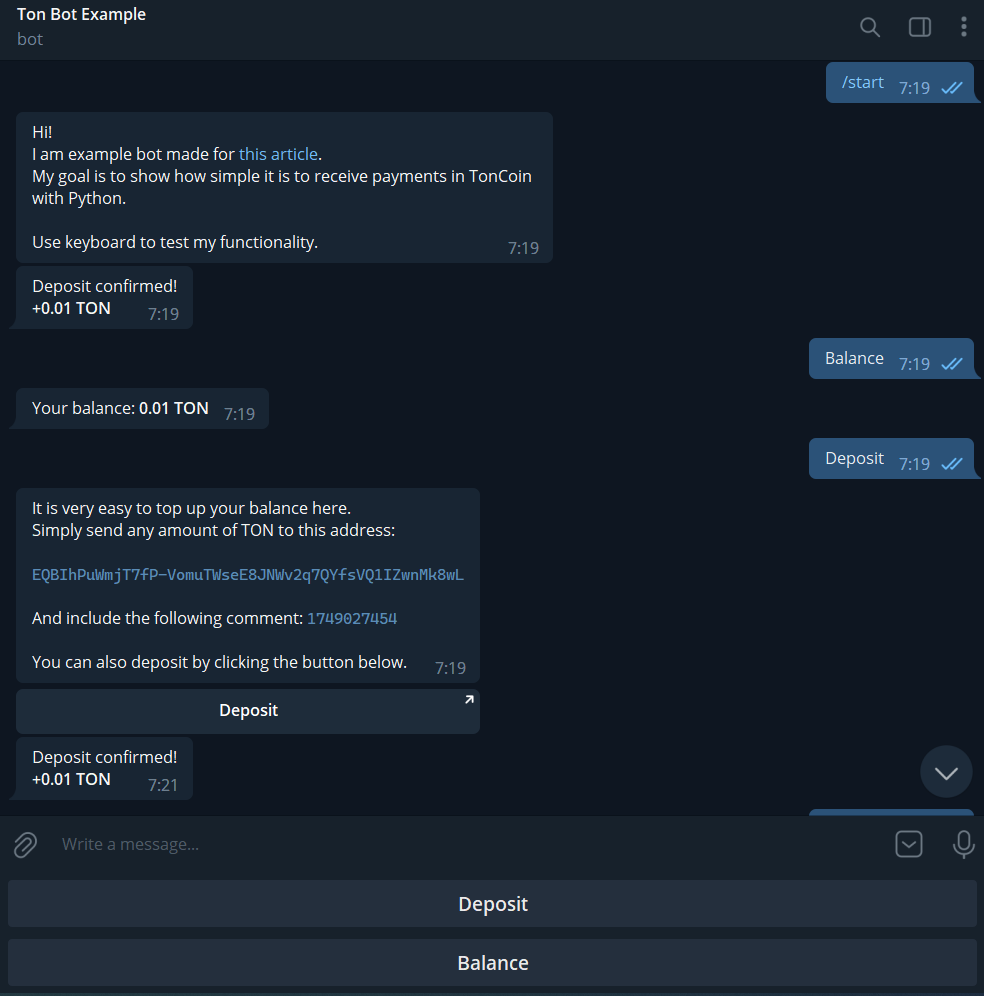带有自己余额的机器人
在本文中,我们将创建一个简单的Telegram机器人,用于接收TON支付。
🦄 外观
机器人将如下所示:

源代码
源代码可在GitHub上获得:
📖 你将学到什么
你将学会:
- 使用Aiogram在Python3中创建一个Telegram机器人
- 使用SQLITE数据库
- 使用公共TON API
✍️ 开始之前你需要
如果还没有安装Python,请先安装。
还需要以下PyPi库:
- aiogram
- requests
你可以在终端中用一条命令安装它们。
pip install aiogram==2.21 requests
🚀 开始吧!
为我们的机器人创建一个目录,其中包含四个文件:
bot.py—运行Telegram机器人的程序config.py—配置文件db.py—与sqlite3数据库交互的模块ton.py—处理TON支付的模块
目录应该看起来像这样:
my_bot
├── bot.py
├── config.py
├── db.py
└── ton.py
现在,让我们开始编写代码吧!
配置
我们先从config.py开始,因为它是最小的一个。我们只需要在其中设置一些参数。
config.py
BOT_TOKEN = 'YOUR BOT TOKEN'
DEPOSIT_ADDRESS = 'YOUR DEPOSIT ADDRESS'
API_KEY = 'YOUR API KEY'
RUN_IN_MAINNET = True # Switch True/False to change mainnet to testnet
if RUN_IN_MAINNET:
API_BASE_URL = 'https://toncenter.com'
else:
API_BASE_URL = 'https://testnet.toncenter.com'
这里你需要在前三行填入值:
BOT_TOKEN是你的Telegram机器人令牌,可以在创建机器人后获得。DEPOSIT_ADDRESS是你的项目钱包地址,将接受所有支付。你可以简单地创建一个新的TON钱包并复制其地址。API_KEY是你从TON Center获得的API密钥,可以在这个机器人中获得。
你还可以选择你的机器人是运行在测试网上还是主网上(第4行)。
配置文件就是这些了,我们可以继续向前了!
数据库
现在让我们编辑db.py文件,该文件将处理我们机器人的数据库。
导入sqlite3库。
import sqlite3
初始化数据库连接和游标(你可以选择任何文件名,而不仅限于db.sqlite)。
con = sqlite3.connect('db.sqlite')
cur = con.cursor()
为了存储关于用户的信息(在我们的案例中是他们的余额),创建一个名为"Users"的表,包含用户ID和余额行。
cur.execute('''CREATE TABLE IF NOT EXISTS Users (
uid INTEGER,
balance INTEGER
)''')
con.commit()
现在我们需要声明一些函数来处理数据库。
add_user函数将用于将新用户插入数据库。
def add_user(uid):
# new user always has balance = 0
cur.execute(f'INSERT INTO Users VALUES ({uid}, 0)')
con.commit()
check_user函数将用于检查用户是否存在于数据库中。
def check_user(uid):
cur.execute(f'SELECT * FROM Users WHERE uid = {uid}')
user = cur.fetchone()
if user:
return True
return False
add_balance函数将用于增加用户的余额。
def add_balance(uid, amount):
cur.execute(f'UPDATE Users SET balance = balance + {amount} WHERE uid = {uid}')
con.commit()
get_balance函数将用于检索用户的余额。
def get_balance(uid):
cur.execute(f'SELECT balance FROM Users WHERE uid = {uid}')
balance = cur.fetchone()[0]
return balance
db.py文件的内容就这些了!
现在,我们可以在机器人的其他组件中使用这四个函数来处理数据库。
TON Center API
在ton.py文件中,我们将声明一个函数,该函数将处理所有新的存款,增加用户余额,并通知用户。
getTransactions 方法
我们将使用TON Center API。他们的文档在这里: https://toncenter.com/api/v2/
我们需要getTransactions方法来获取某个账户最新交易的信息。
让我们看看这个方法作为输入参数需要什么以及它返回了什么。
只有一个必填的输入字段address,但我们还需要limit字段来指定我们想要返回多少个交易。
现在让我们尝试在TON Center 网站上运行这个方法,使用任何一个已存在的钱包地址,以了解我们应该从输出中得到什么。
{
"ok": true,
"result": [
{
...
},
{
...
}
]
}
好的,所以当一切正常时,ok字段被设置为true,并且我们有一个数组result,列出了limit最近的交易。现在让我们看看单个交易:
{
"@type": "raw.transaction",
"utime": 1666648337,
"data": "...",
"transaction_id": {
"@type": "internal.transactionId",
"lt": "32294193000003",
"hash": "ez3LKZq4KCNNLRU/G4YbUweM74D9xg/tWK0NyfuNcxA="
},
"fee": "105608",
"storage_fee": "5608",
"other_fee": "100000",
"in_msg": {
"@type": "raw.message",
"source": "EQBIhPuWmjT7fP-VomuTWseE8JNWv2q7QYfsVQ1IZwnMk8wL",
"destination": "EQBKgXCNLPexWhs2L79kiARR1phGH1LwXxRbNsCFF9doc2lN",
"value": "100000000",
"fwd_fee": "666672",
"ihr_fee": "0",
"created_lt": "32294193000002",
"body_hash": "tDJM2A4YFee5edKRfQWLML5XIJtb5FLq0jFvDXpv0xI=",
"msg_data": {
"@type": "msg.dataText",
"text": "SGVsbG8sIHdvcmxkIQ=="
},
"message": "Hello, world!"
},
"out_msgs": []
}
我们可以看到可以帮助我们识别确切交易的信息存储在transaction_id字段中。我们需要从中获取lt字段,以了解哪个交易先发生,哪个后发生。
关于coin转移的信息在in_msg字段中。我们需要从中获取value和message。
现在我们准备好创建支付处理程序了。
从代码中发送 API 请求
让我们从导入所需的库和之前的两个文件config.py和db.py开始。
import requests
import asyncio
# Aiogram
from aiogram import Bot
from aiogram.types import ParseMode
# We also need config and database here
import config
import db
让我们考虑如何可以实现支付处理。
我们可以每隔几秒调用API,并检查我们的钱包地址是否有任何新交易。
为此,我们需要知道最后处理的交易是什么。最简单的方法是只将该交易的信息保存在某个文件中,并在我们处理新交易时更新它。
我们需要将哪些交易信息存储在文件中?实际上,我们只需要存储lt值——逻辑时间。有了这个值,我们就能知道需要处理哪些交易。
所以我们需要定义一个新的异步函数;让我们称之为start。为什么这个函数需要是异步的?因为Telegram机器人的Aiogram库也是异步的,稍后使用异步函数会更容易。
这是我们的start函数应该看起来的样子:
async def start():
try:
# Try to load last_lt from file
with open('last_lt.txt', 'r') as f:
last_lt = int(f.read())
except FileNotFoundError:
# If file not found, set last_lt to 0
last_lt = 0
# We need the Bot instance here to send deposit notifications to users
bot = Bot(token=config.BOT_TOKEN)
while True:
# Here we will call API every few seconds and fetch new transactions.
...
现在让我们编写while循环的主体。我们需要每隔几秒在这里调用TON Center API。
while True:
# 2 Seconds delay between checks
await asyncio.sleep(2)
# API call to TON Center that returns last 100 transactions of our wallet
resp = requests.get(f'{config.API_BASE_URL}/api/v2/getTransactions?'
f'address={config.DEPOSIT_ADDRESS}&limit=100&'
f'archival=true&api_key={config.API_KEY}').json()
# If call was not successful, try again
if not resp['ok']:
continue
...
在使用requests.get调用后,我们有一个变量resp包含了API的响应。resp是一个对象,resp['result']是一个列表,包含了我们地址的最后100笔交易。
现在我们只需遍历这些交易,找到新的交易即可。
while True:
...
# Iterating over transactions
for tx in resp['result']:
# LT is Logical Time and Hash is hash of our transaction
lt, hash = int(tx['transaction_id']['lt']), tx['transaction_id']['hash']
# If this transaction's logical time is lower than our last_lt,
# we already processed it, so skip it
if lt <= last_lt:
continue
# at this moment, `tx` is some new transaction that we haven't processed yet
...
我们如何处理一笔新的交易呢?我们需要:
- 理解哪个用户发送了它
- 增加该用户的余额
- 通知用户他们的存款
下面是将完成所有这些操作的代码:
while True:
...
for tx in resp['result']:
...
# at this moment, `tx` is some new transaction that we haven't processed yet
value = int(tx['in_msg']['value'])
if value > 0:
uid = tx['in_msg']['message']
if not uid.isdigit():
continue
uid = int(uid)
if not db.check_user(uid):
continue
db.add_balance(uid, value)
await bot.send_message(uid, 'Deposit confirmed!\n'
f'*+{value / 1e9:.2f} TON*',
parse_mode=ParseMode.MARKDOWN)
让我们看看它做了什么。
所有有关coin转移的信息都在tx['in_msg']中。我们只需要其中的'value'和'message'字段。
首先,我们检查值是否大于零,如果是,才继续。
然后我们期望转移有一个评论(tx['in_msg']['message']),以有我们机器人的用户ID,所以我们验证它是否是一个有效的数字,以及该UID是否存在于我们的数据库中。
经过这些简单的检查,我们有了一个变量value,它是存款金额,和一个变量uid,它是进行此次存款的用户ID。所以我们可以直接给他们的账户增加资金,并发送通知消息。
同时注意值默认是以nanotons为单位的,所以我们需要将其除以10亿。我们在通知消息中这样做:
{value / 1e9:.2f}
这里我们将值除以1e9(10亿),并保留小数点后两位数字,以便以用户友好的格式显示给用户。
太棒了!程序现在可以处理新交易并通知用户存款情况。但我们不应忘记之前我们使用过的lt,我们必须更新最后的lt,因为处理了一个更新的交易。
这很简单:
while True:
...
for tx in resp['result']:
...
# we have processed this tx
# lt variable here contains LT of the last processed transaction
last_lt = lt
with open('last_lt.txt', 'w') as f:
f.write(str(last_lt))
ton.py文件的内容就这些了!
我们的机器人现在已完成3/4;我们只需要在机器人自身创建一个包含几个按钮的用户界面。
Telegram 机器人
初始化
打开bot.py文件并导入我们所需的所有模块。
# Logging module
import logging
# Aiogram imports
from aiogram import Bot, Dispatcher, types
from aiogram.dispatcher.filters import Text
from aiogram.types import ParseMode, ReplyKeyboardMarkup, KeyboardButton, \
InlineKeyboardMarkup, InlineKeyboardButton
from aiogram.utils import executor
# Local modules to work with the Database and TON Network
import config
import ton
import db
让我们设置日志记录,以便我们以后可以看到发生的事情以便调试。
logging.basicConfig(level=logging.INFO)
现在我们需要使用Aiogram初始化机器人对象及其调度器。
bot = Bot(token=config.BOT_TOKEN)
dp = Dispatcher(bot)
这里我们使用了教程开始时我们创建的配置中的BOT_TOKEN。
我们初始化了机器人,但它仍然是空的。我们必须添加一些与用户交互的功能。
消息处理器
/start 命令
我们首先处理/start和/help命令。当用户第一次启动机器人、重新启动它或使用/help命令时,将调用此函数。
@dp.message_handler(commands=['start', 'help'])
async def welcome_handler(message: types.Message):
uid = message.from_user.id # Not neccessary, just to make code shorter
# If user doesn't exist in database, insert it
if not db.check_user(uid):
db.add_user(uid)
# Keyboard with two main buttons: Deposit and Balance
keyboard = ReplyKeyboardMarkup(resize_keyboard=True)
keyboard.row(KeyboardButton('Deposit'))
keyboard.row(KeyboardButton('Balance'))
# Send welcome text and include the keyboard
await message.answer('Hi!\nI am example bot '
'made for [this article](/develop/dapps/payment-processing/accept-payments-in-a-telegram-bot-2).\n'
'My goal is to show how simple it is to receive '
'payments in Toncoin with Python.\n\n'
'Use keyboard to test my functionality.',
reply_markup=keyboard,
parse_mode=ParseMode.MARKDOWN)
欢迎消息可以是你想要的任何内容。键盘按钮可以是任何文本,但在这个示例中,它们被标记为我们的机器人最清晰的方式:Deposit和Balance。
余额(Balance)按钮
现在用户可以启动机器人并看到带有两个按钮的键盘。但在调用其中一个后,用户不会收到任何响应,因为我们还没有为它们创建任何功能。
所以让我们添加一个请求余额的功能。
@dp.message_handler(commands='balance')
@dp.message_handler(Text(equals='balance', ignore_case=True))
async def balance_handler(message: types.Message):
uid = message.from_user.id
# Get user balance from database
# Also don't forget that 1 TON = 1e9 (billion) Nanoton
user_balance = db.get_balance(uid) / 1e9
# Format balance and send to user
await message.answer(f'Your balance: *{user_balance:.2f} TON*',
parse_mode=ParseMode.MARKDOWN)
这非常简单。我们只需从数据库获取余额并向用户发送消息。
存款(Deposit)按钮
那第二个Deposit按钮呢?这是它的函数:
@dp.message_handler(commands='deposit')
@dp.message_handler(Text(equals='deposit', ignore_case=True))
async def deposit_handler(message: types.Message):
uid = message.from_user.id
# Keyboard with deposit URL
keyboard = InlineKeyboardMarkup()
button = InlineKeyboardButton('Deposit',
url=f'ton://transfer/{config.DEPOSIT_ADDRESS}&text={uid}')
keyboard.add(button)
# Send text that explains how to make a deposit into bot to user
await message.answer('It is very easy to top up your balance here.\n'
'Simply send any amount of TON to this address:\n\n'
f'`{config.DEPOSIT_ADDRESS}`\n\n'
f'And include the following comment: `{uid}`\n\n'
'You can also deposit by clicking the button below.',
reply_markup=keyboard,
parse_mode=ParseMode.MARKDOWN)
这里我们要做的也很容易理解。
还记得在ton.py文件中,我们是如何通过评论确定哪个用户进行了存款吗?现在在机器人中,我们需要请求用户发送包含他们UID的交易。
启动机器人
现在在bot.py中我们要做的最后一件事是启动机器人本身,同时也运行ton.py中的start函数。
if __name__ == '__main__':
# Create Aiogram executor for our bot
ex = executor.Executor(dp)
# Launch the deposit waiter with our executor
ex.loop.create_task(ton.start())
# Launch the bot
ex.start_polling()
此时,我们已经编写了我们机器人所需的所有代码。如果你按照教程正确完成,当你使用python my-bot/bot.py命令在终端运行时,它应该会工作。
如果你的机器人不能正确工作,请与这个库的代码进行对比。
参考资料
- 作为ton-footsteps/8的一部分
- 由Gusarich提供(Telegram @Gusarich, Gusarich on GitHub)